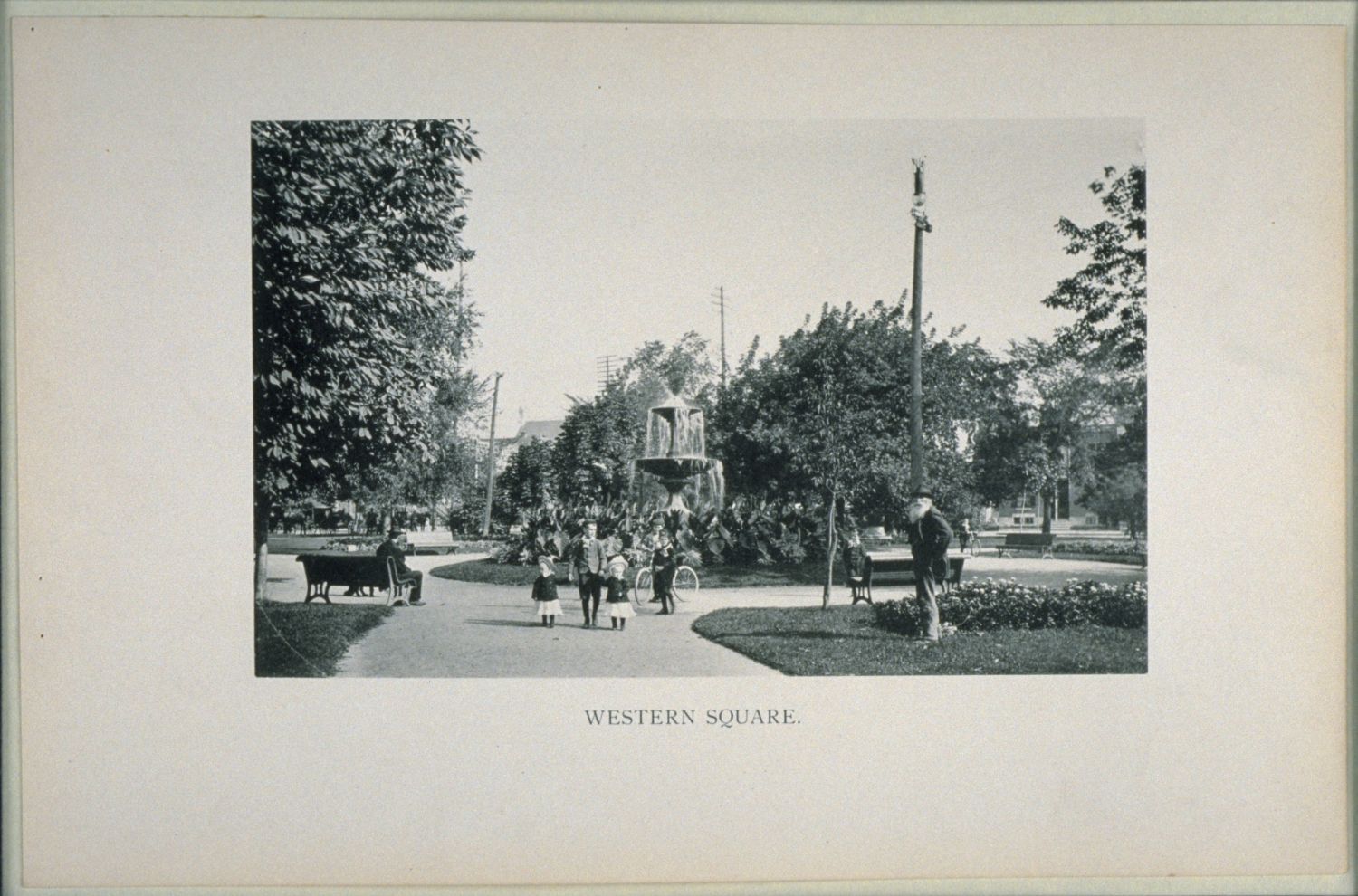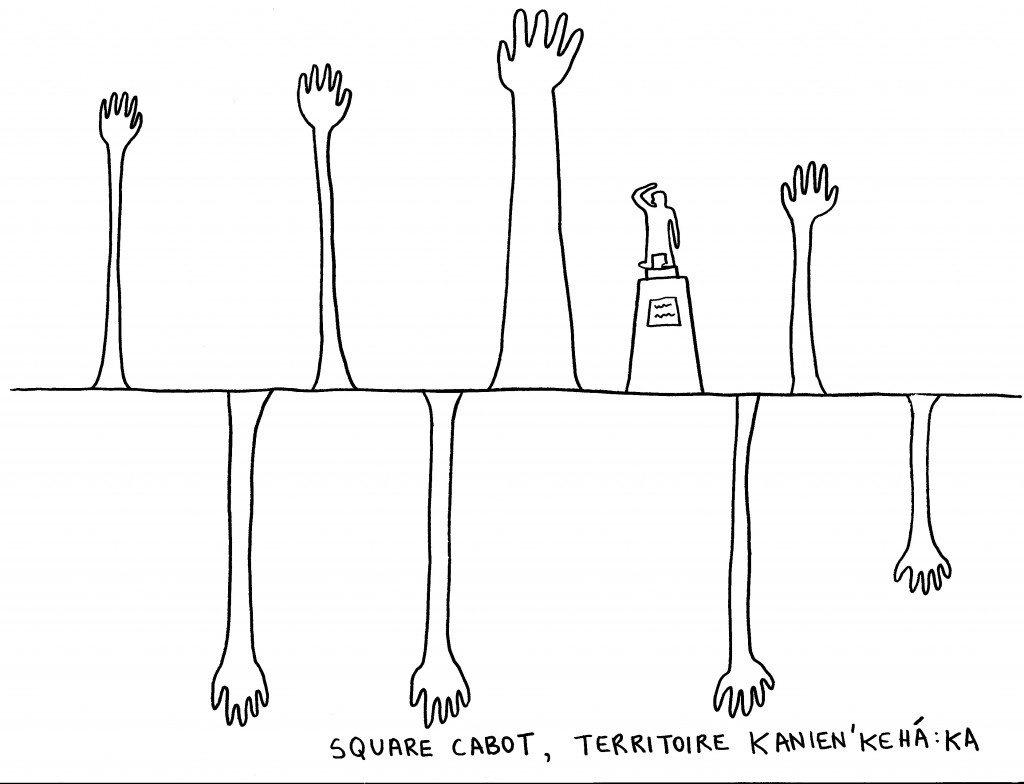If you are reading this in Montreal, you are on unceded Kanien’kehá:ka territory. If you are reading this anywhere else in North America, you are on unceded indigenous land, too.
All public space is contested space and Cabot Square is no exception. Located in Montreal’s Shaughnessy Village on the block bordered by Atwater Avenue, Saint-Catherine, Lambert-Closse, and Tupper Streets, the park was first established in 1890. In spite of the obvious continuities of the space, it has undergone many changes and has been the site of various conflicts, ranging from competing nationalisms, to sports riots, to fraught relations between homeless and the police. In the last thirty years, it has become a gathering place for Indigenous people in downtown Montreal, offering a central location for community outreach programs.
My interest in Cabot Square lies in its design. Through my research I learned that many landscape architects have been involved with its transformations over the last 100 years. It may seem obvious, but parks are designed spaces. Every urban park design contains within it the desire to control behaviour and to order space and nature. Every tree in Cabot Square was planted by a human hand as part of a careful plan.
With this in mind, I wondered how the lines and values expressed in Cabot Square over the years participate in a colonial discourse. As a settler-Canadian artist, I wanted to call attention to the actions of settlers on unceded indigenous land. My intervention colonial by design: unsettling postcards of cabot square responds to this history of urban park design in North America.


Part of this project also involves critiquing the absence of Indigenous recognition in the heritage document for Cabot Square, which starts with the development of the land for a park space by Sulpician priests in the 1860s. Inspired by postcards of Cabot Square (formerly Western Square) dating from the early twentieth century (see above), my project consists of four hand-drawn postcards. These postcards aim to unsettle the discourse of Cabot Square by engaging with some of the hard truths of settler-colonialism.
The four postcards, entitled handscape, unseated, people watching, and revisions destabilize the narrative of Cabot Square as it has been written. All four designs are intended to be uncomfortable or ‘off’ in some way. This is my attempt to disrupt the linear and comfortable narrative of the park perpetuated by municipal documents.
postcard #1: handscape (2016)

postcard #2: unseated (2016)

postcard #3: people watching (2016)

postcard #4: revisions (2016)

On April 20th, 2016 I did an onsite intervention in Cabot Square, placing the postcards in the earth. I also held postcards in front of various sites, such as the Cabot monument and neighbouring condo developments. After documenting these interventions, I handed out my postcards to passersby in the park and engaged in some enriching conversations about gentrification and urban wildlife.
Here are photos from that intervention:
*** I would like to acknowledge artists Jeff Thomas and Basil Alzeri, whose works planted seeds in my consciousness a few years ago, no doubt influencing the execution of this project.
Bazil Alzeri’s Postcard Project II
— Gabrielle Doiron
Bibliography
Breitkreutz, Sara. 2014. “Stories of Place: Urban Community and Contested Space in Montreal’s Cabot Square.” MA Thesis, Concordia University.
Brück, Joanna. 2013. “Landscapes of Desire: Parks, Colonialism, and Identity in Victorian and Edwardian Ireland.” International Journal of Historical Geography 17.1: 196-223.
CBC News. 2015. “Missing and murdered indigenous women remembered in annual march.” October 4. Accessed 10 February 2016.
D’Andrea, Giuliano E. 1989. “When Nationalisms Collide: Montreal’s Italian Community and the St.Leonard Crisis, 1967-1969.” MA Thesis, McGill University.
Goeman, Mishuanna. 2013. “Introduction.” In Mark My Words: Native Women Mapping Our Nations, 1-39. Minneapolis: University of Minnesota Press.
Massey, Doreen. 2005. For Space. London: SAGE Publications.
Montreal Urban Aboriginal Community Strategy NETWORK (abbreviated to NETWORK in citations). 2013. “Final Report – Project: Learning from Cabot Square – Developing the Strategy for Community Safety and Wellbeing.” Montreal. July (Updated October). Accessed 12 February 2016.
—. 2015. NETWORK STRATEGIC PLAN 2012-2017. Montreal. Accessed 11 Feb 2016.
Nagam, Julie. 2013. “Charting Indigenous Stories of Place: An Alternate Cartography Through the Visual Narrative of Jeff Thomas.” In Diverse Spaces: Identity, Heritage and Community in Canadian Public Culture, 188-207. Newcastle Upon Tyne: Cambridge Scholars Publishing.
Okeke, Shari. 2015. “New Cabot Square park aims to empower aboriginal Montrealers.” CBC NEWS, June 18. Accessed 10 February 2016.
The Cabot Square Project Facebook Page. Accessed 13 Feburary 2016.
Ville de Montréal. 2013. Énoncé d’intérêt patrimonial – Square Cabot – Arrondissement de Ville-Marie. Montréal, Division du patrimoine. 15 July. Accessed 11 February 2016.











